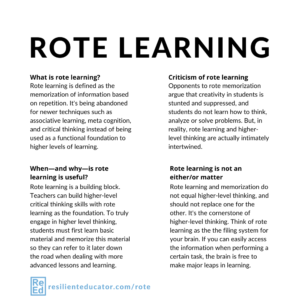
Rote learning is defined as the memorization of information based on repetition. The two best examples of rote learning are the alphabet and numbers. Slightly more complicated examples include multiplication tables and spelling words. At the high-school level, scientific elements and their chemical numbers must be memorized by rote. And, many times, teachers use rote learning without even realizing they do so.
Does rote learning have a place in 21st-century education?
Is rote learning an outdated technique or is there a valid place for its use in the classroom today? Increasingly, rote learning is being abandoned for newer techniques such as associative learning, meta cognition, and critical thinking instead of being used as a functional foundation to higher levels of learning.
It’s always useful to apply meaningful relationships to basic skills. At the end of the day, however, rote learning plays a bigger role than most teachers would like to recognize in today’s learning climate. It’s up to us to leverage our own unique teaching methods to produce the most effective learning environment for our students, and it’s important to keep an open mind around “the right” approach.
The difference between memory and intelligence
The mental ability to memorize is often used as an indicator of intelligence. No doubt, the two are strongly linked, but memory is not always a reliable indicator of intelligence. Working memory does not directly affect the level of intelligence of a student.
Most of the time, a deficit in working memory is due to the structure of learning. Think of working memory as a filing cabinet. If each piece of information has a separate file, finding the information becomes difficult. If factors such as stress, lack of sleep, and distractions are involved, finding the information is even harder. Instead, effective memorization involves categorization of the information and sections within sections of the filing cabinet.
Memory is not a strong indicator of intelligence. Instead, it is linked to interaction of environmental factors and training.
When is there a problem with rote learning?
When rote memorization is applied as the main focus of learning, it is not considered higher-level thought or critical thinking. Opponents to rote memorization argue that creativity in students is stunted and suppressed, and students do not learn how to think, analyze or solve problems. These educators believe, instead, that a more associative or constructive learning should be applied in the classroom. If the majority of the student’s day is spent on repetition, the foundation for learning becomes shaky.
Oftentimes, teachers are scorned for “teaching to the test,” referring to standardized testing, and are criticized for applying rote memorization as a foundational skill. When the role of rote memorization is an end in itself, instead of a means to an end, rote memorization fails as a building block to critical thinking.
When the argument focuses on rote learning as an either/or situation, rote learning is stigmatized as a technique that “lazy” or “uninformed” teachers use. But, in reality, rote learning and higher-level thinking are actually intimately intertwined.
When—and why—is rote learning is useful?
As an alternative approach to subject areas that require memorization with disdain and conflict, teachers can build higher-level critical thinking skills with rote learning as the foundation.
Rote learning as a building block
Consider this: How do students learn the alphabet or multiplication tables if not through rote memorization? For that matter, can a high school chemistry student progress without having the Table of Elements memorized?
While it’s not a means to an end, rote learning is necessary if you want to engage in higher-level thinking. After all, can you do calculus or engineering-math, or even basic algebra, if you constantly have to remember how to multiply or look up functions and operations? That method would take forever. And you won’t likely have “ah-ha” moments or breakthroughs.
As another example, these same principles also applies to spelling. Although everyone today uses word processors with spell check, spelling is still important when filling out forms and writing letters. Knowing how to spell makes writing easier and faster.
To truly engage in higher level thinking, students must first learn basic material and memorize this material so they can refer to it later down the road when dealing with more advanced lessons and learning.
Rote learning is not an either/or matter
Rote learning and memorization do not equal higher-level thinking, and should not replace one for the other. Rote learning, however, is the cornerstone of higher-level thinking and should not be ignored. Especially in today’s advanced technological world, rote memorization might be even more important than ever! Think of rote learning as the the filing system for your brain. If you can easily access the information when performing a certain task, the brain is free to make major leaps in learning.

Categorized as: Tips for Teachers and Classroom Resources
Tagged as: Assessment Tools, Pros and Cons
